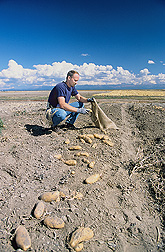Washington, DC, USA
June 3, 2010
 Potatoes offering elevated levels of phytonutrients thought to promote health could add a new dimension to the consumer diet. But the journey from farm to fork can be a perilous one fraught with sundry microorganisms ready to attack the spuds, either while they're still in the ground or during storage.
Potatoes offering elevated levels of phytonutrients thought to promote health could add a new dimension to the consumer diet. But the journey from farm to fork can be a perilous one fraught with sundry microorganisms ready to attack the spuds, either while they're still in the ground or during storage.
In Aberdeen, Idaho, Agricultural Research Service (ARS) scientists Rich Novy and Jonathan Whitworth are taking on the late-blight fungus, Phytophthora infestans, best known for its role in the Irish potato famine of 1845. They work at the ARS Small Grains and Potato Germplasm Research Unit in Aberdeen.
Novy, a geneticist, and Whitworth, a plant pathologist, coordinate a unique program at Aberdeen to develop new potato lines that resist different biotypes of late blight. Toward that end, they send 2,500 breeding "clones" annually to Héctor Lozoya-Saldaña, a collaborator in Chapingo, Mexico, where late blight is endemic.
Based on Lozoya-Saldaña's evaluations, Novy and Whitworth conduct a duplicate planting of the clones and select the most resistant ones for further advancement based on their agronomic performance under irrigated production.
Defender, a 2006 release from the program, has helped growers save on fungicides and other expenses associated with controlling late blight, which attacks the crop's leaves and tubers, rendering the latter unmarketable.
Over the next few years, Defender may be joined by another late-blight-resistant variety, depending on how it performs in ongoing trials in Idaho, Oregon, Washington, California and Texas, reports Novy.
Potatoes such as Defender are typically released in collaboration with university colleagues and the grower-supported Potato Variety Management Institute. The tubers are primarily intended for production in the western United States, but requests for releases also originate from other regions of the country as well as outside of the United States, where some of the same problems occur.
Read more about this and other ARS potato projects in the May/June 2010 issue of Agricultural Research magazine, available online at: http://www.ars.usda.gov/is/AR/archive/may10/potatoes0510.htm.
Photo: Geneticist Rich Novy harvests tubers of a potato breeding clone at Tetonia, Idaho.
Photo by Peggy Greb.
Científicos buscan líneas de papa que tienen resistencia al tizón tardío
Las papas que ofrecen niveles elevados de fitonutrientes podrían beneficiar a la salud humana. Pero el viaje desde la granja hasta el tenedor puede ser muy difícil para la papa, con muchos microorganismos listos para atacar las papas mientras están todavía en la granja o durante el almacenamiento.
En Aberdeen, Idaho, científicos Rich Novy y Jonathan Whitworth con el Servicio de Investigación Agrícola (ARS) están estudiando el hongo del tizón tardío, Phytopthora infestans, el cual tuvo un papel principal en la Gran Hambruna Irlandesa del 1845 al 1849. Los científicos trabajan en la Unidad de Investigación de Granos Pequeños y Germoplasma de Papa mantenida por el ARS en Aberdeen.
Novy, quien es genetista, y Whitworth, quien es patólogo de plantas, coordinan un programa único en Aberdeen para desarrollar nuevas líneas de papa que resisten biotipos diferentes del tizón tardío. Hacia ese propósito, ellos envían 2.500 "clones" de crianza anualmente a Héctor Lozoya-Saldaña, quien es un colaborador en Chapingo, México, donde el tizón tardío es endémico.
Basado en la evaluaciones por Lozoya-Saldaña, Novy y Whitworth realizan una plantación duplicada de los clones y seleccionan las plantas que tienen los niveles más altos de resistencia para estudios adicionales basados en su funcionamiento agronómica en un sistema de producción irrigada.
‘Defender', la cual es una variedad de papa lanzada en el 2006 del programa de crianza, ha ayudado a los cultivadores a reducir su uso de pesticidas y los gastos relacionados con el control del tizón tardío, el cual ataca las hojas de las plantas y las papas, con el resultado de que las papas no son vendibles.
Durante los pocos próximos años, el programa podría producir otra variedad que ofrece resistencia al tizón tardío, basado en su funcionamiento en pruebas ahora en curso en Idaho, Oregón, Washington, California y Texas, según Novy.
Papas tales como ‘Defender' típicamente se lanzan en colaboración con colegas universitarios y el Instituto de Manejo de Variedades de Papa, el cual es apoyado por los cultivadores. Las papas van dirigidas a los cultivadores de la región occidental de EE.UU., pero también hay solicitudes de otras regiones de EE.UU. y otros países, donde estos problemas ocurren.
Lea más sobre esta investigación y otros proyectos de ARS relacionados con la papa en la revista ‘Agricultural Research' de mayo-junio del 2010.
http://www.ars.usda.gov/is/AR/archive/may10/potatoes0510.htm
ARS es la agencia principal de investigaciones científicas del Departamento de Agricultura de EE.UU. (USDA por sus siglas en inglés). Esta investigación apoya la prioridad del USDA de promover la seguridad alimentaria internacional.